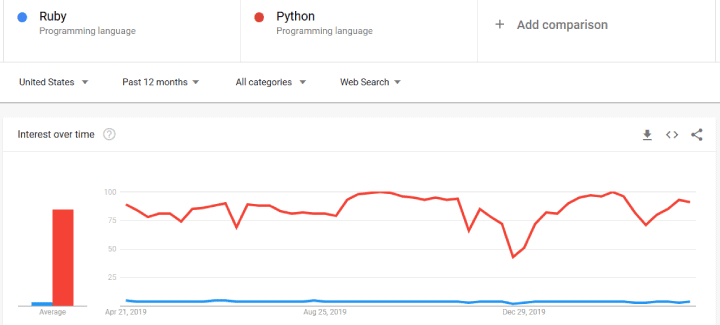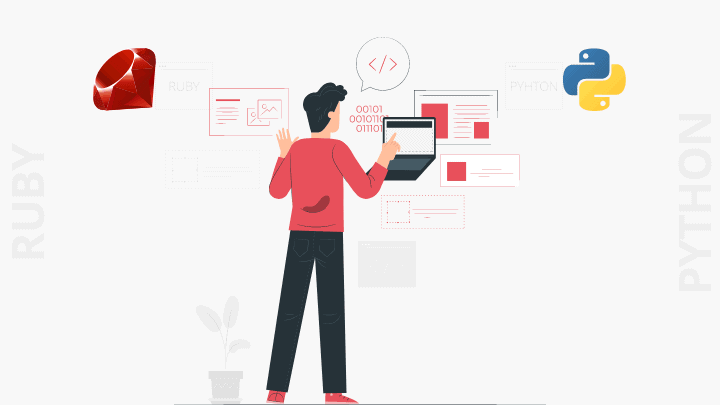
Ruby vs Python: If you are thinking of your next web application development, you must be wondering what programming language to choose along with which technology framework that can provide the best tools for your project. This is where Ruby on Rails and Django comes into the scenario. Both of these frameworks offer views, controllers, models that empower your web app.
However, Django which uses python language is rapidly growing in terms of popularity in comparison to Ruby on Rails. Let’s understand both Ruby vs Python programming language in detail:
Ruby – A dynamic and open source programming language
Ruby is a dynamic, open-source programming language used to build web applications. The object-oriented programming language offers a distinct set of libraries that allow programmers to write the same code in different ways. Ruby on Rails (RoR) is a standalone model that works on MVC (Model-View-Controller) architecture.
Python – An interpreted and high-level programming language
Python is an object-oriented programming language that allows you to work quickly and more effectively with easy to learn and simple syntax. Python is widely used for large scale web development as it incorporates exclusive development features that make it possible to execute the program using different frameworks such as Flask, Django, etc.
Ruby vs Python: How are they different?
Ruby is a dynamic, open-source, object-oriented programming language that runs over all types of operating systems, including Windows, UNIX, and Macintosh. However, Python is a powerful, simple, easy to learn, high level, object-oriented programming language, which is also an interpreted scripting language. Though both these programming languages are quite similar, they differ in terms of language, flexibility, web frameworks, and other factors.
1. Language
Ruby is a flexible and easy coding language for web developers that makes it possible to practice numerous tricks for developing enterprise web apps. On the other side, Python integrates a more direct approach where everything is precisely visible to the web developer.
2. Flexibility & Popularity
Ruby inherits Perl’s philosophy that says, “There’s more than one way to do it.” Therefore, it offers multiple ways to accomplish a task, which sometimes accelerates the complexity levels. Python works on the philosophy of “There should be one—and preferably only one—obvious way to do it.” Though Python’s code is not flexible, it is more readable to even the amateur programmers. When it comes to popularity, Python is more popular by being the third most used language for web development.
3. Testing & Troubleshooting
No matter what programming language and web framework you choose for your next web app development, testing the code is a crucial step and must be followed as early as possible in the development process. Both Ruby and Python possess capable toolsets for effective testing and troubleshooting.
4. Web Frameworks
Both Ruby on Rails and Django helps you build responsive web applications. Since both Ruby and Python are programming languages, they deliver similar performance. Both languages are based on the MVC framework; they provide traditional models, controllers, views, and database migrations.
5. Reusable Code
Reusable codes in Ruby are known as “Gems” whereas, in Python, they are called “Modules”. In Python, the modules are available through PyPI, and the user can search for more than 1,50,000 modules. In Ruby, the users can search around 1,50,000 gems.
6. Usage
Both Ruby vs Python programming languages are popular in the world of technology and web development. Ruby can be seen on popular websites that include Apple, Airbnb, Groupon, Shopify, Twitter, and Github. On the other hand, examples of Python websites include Instagram, Google, Mozilla Firefox, Pinterest, Washington Post, and National Geographic.
7. Performance
While choosing a programming language for your next web application project, performance must not be a deciding factor as the initial objective of the coding is to solve the proposed problem. If you decide on selecting an open-source programming language, the possibilities are that an optimized library must already exist for achieving the intended goal.
Ruby vs Python – Head-to-Head Comparison
| Ruby | Python | |
|---|---|---|
| Developed by | Created in 1995 by Yukihiro “Matz” Matsumoto | Created in 1991 by Guido Van Rossum |
| Web frameworks | Ruby on Rails | Django |
| Libraries | A smaller range of library than Python | larger range of libraries |
| IDEs | Supported by EclipseIDE | Supported by multiple IDEs |
| Functions | No | Yes |
| Anonymous functions | It supports blocks, procs, and lambdas. | It supports only lambdas. |
| Lambda functions | It supports larger lambda functions. | It supports single line lambda function only. |
| Switch/Case statement | Supported | Not Supported |
| Built-in classes | It can’t be modified. | It can be modified. |
| Inheritance | It supports single inheritance. | It supports multiple inheritance. |
| Usage by | Apple, Groupon, Airbnb, Github, Twitter, and Shopify, etc. | Instagram, Google, Mozilla Firefox, Pinterest, Washington Post, and National Geographic, etc. |
How are Python and Ruby similar?
The similarities between the Ruby and the Python programming languages are as follows:
- Both are used for web application development
- Both are high-level scripting languages
- Both are server-side scripting languages
- Both works on interactive prompt, named as IRB
- Both integrate embedded doc tools
- Both programming languages are supported by Emacs modes
- Both Ruby and Python integrates GNU Debugger
- Both scripting languages work on multiple platforms
- In both the platforms, objects are typed using a dynamic and robust approach
- Both the languages are written in a clean syntax
- Both Ruby and Python are highly readable
Reasons to choose Ruby for web app development
Ruby is the most popular development language which uses the Rails framework. Most IT professionals prefer Ruby for developing a highly interactive application due to several compelling reasons that include:
1. Less coding: Ruby works on the concept of less coding and more functionality. Some of the primary principles of ROR include Create, Read, Update, Delete (CRUD), convention over configuration (COC), and KISAP (keep it simple as possible).
2. Quick to embrace new things: The programming process is much faster than other languages and frameworks. It is suitable for RAD (Rapid Application Development) as it accommodates changes more quickly and efficiently.
3. Based on agile development principles: The task is divided into small parts so that each task can be executed quickly.
4. Easy testing environment: Ruby integrates a reliable testing framework. Automated coding reduces testing time.
5. Free to use: Ruby is an open-source programming language, which means it’s available free of cost. It is an ideal language for start-ups, and simple coding makes it one of the best options available for developers.
Reasons to choose Python for web application development
Python’s popularity is influenced by the countless benefits that it offers, including elegance and simplicity. Unarguably, it is one of the best programming languages used worldwide in a simple to complex web application development projects. The language is used in different domains, including healthcare, finance, travel, transportation, etc. some of the reasons why Python is popular among developers are:
1. Easy to use and read: Python is easy to use and understand because it is similar to the English language that we use in our everyday life. It integrates simple syntax, and every element has a concise and transparent relationship with each other.
2. Use in Multiple Spheres: Usability, including web development, academia, machine learning, data analysis, and scientific programming as Python, has highly efficient packages and tools for visualization outputs.
3. Asynchronous coding: Writing and maintaining asynchronous coding using Python saves time as no deadlocks or other concerns exist.
4. Enterprise application integration: Python is undoubtedly the first choice for enterprise application integration as it integrates seamlessly with other highly used programming languages such as Java, .NET, PHP, etc.
5. Server-side scripting: Simple syntax accelerates the application development process, and the credit goes to the server-side scripting attribute of Python.
6. Portability and interactivity: You can easily embed Python in a wide range of applications, even if they use different programming languages. It is easy to fix modules and extend the Python core vocabulary and connect diverse elements.
Should I use Python or Ruby for the next web development project?
Python allows programmers to develop simple and clear applications right from the small-scale projects to complex apps. It is an ideal option for new developers to start with as well as start-ups as it incorporates reduced development risks. It is a flexible programming language that is easy to understand, easy to scale, and highly readable across multiple platforms.
If you want to use a language that’s widely applicable and proficient with managing the data analytics, then Python is an ideal option.
What does the future hold for Ruby or Python?
Both Ruby and Python are strong programming languages with a brilliant future application development capability. They are definite improvements from the .NET and JAVA frameworks as they speed up the mobile app development process. Moreover, they offer clear design and abstraction attributes, which makes them future-ready application development platforms. To sum up, since Python doesn’t only rely upon web development, it infers better longevity than Ruby.
Final Words
Both Ruby and Python programming languages are fast and simple. For projects that include a lot of data computing, processing, and analytics, Python is probably the best option. However, Ruby suits projects that are traffic-heavy and involves rapid prototyping.






